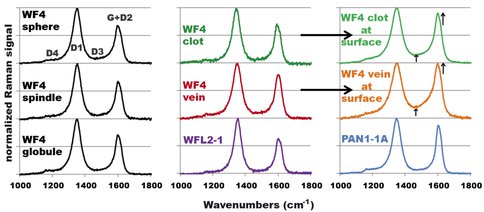2013 Annual Science Report
 University of Wisconsin
Reporting | SEP 2012 – AUG 2013
University of Wisconsin
Reporting | SEP 2012 – AUG 2013
Project 3B: Carbon Isotope Analysis of Archean Microfossils
Project Summary
We have completed a study of petrography, Raman microspectroscopy, and in situ analyses of carbon isotope and H/C ratios using secondary ion mass spectrometry (SIMS) of diverse organic microstructures, including possible microfossils. This work has focussed on two localities of the 3.4-billion-year-old Strelley Pool Formation (Western Australia). For the first time, we show that the wide range of carbon isotope ratios recorded at the micrometer scale correlates with specific types of texture for organic matter (OM), arguing against abiotic processes to produce the textural and isotopic relations. These results support the biogenicity of OM in the Strelley Pool Formation.
Project Progress
Abundant cell-like organic structures have been proposed as microfossils in Paleoarchean (3.2–3.5Ga) cherts. The wide range of δ13C(C-org) values recorded in Paleoarchean organic matter (OM), including some of these possible microfossils, is difficult to reconcile with the smaller range observed in living cells and younger microfossils. Metamorphic and metasomatic effects on δ13C(C-org) have been recognized in Paleoarchean rocks, but have never been assessed for cell-like structures. Migrations of OM, of which the textures can mimic microfossils, are also difficult to constrain in Paleoarchean cherts that are often cut by sub-millimeter- to meter-scale OM-bearing veins. Here, we present the results of petrography, Raman microspectroscopy, and in situ analyses of δ13C(C-org) and H/C using secondary ion mass spectrometry (SIMS) of diverse organic microstructures, including possible microfossils, from two localities of the 3.4-billion-year-old Strelley Pool Formation (Western Australia, SPF).For the first time, we show that the wide range of δ13C(C-org) values recorded at the micrometer scale correlates with specific OM-texture types in the SPF. The crosscutting texture and lower structural order show that the OM in micro-veins of one sample from the Goldsworthy greenstone belt (WF4) post-dates all other OM-texture types. Possible microfossils (spheres, lenses), clots and micrometer-scale globules all show a higher structural order reached during peak metamorphism. Other than late micro-veins, textures indicative of OM migration beyond the millimeter-scale are absent; hence the source of clots, lenses, spheres and globules is indigenous to the cherts. A weak positive relation between δ13C(C-org) and H/C demonstrates that the 10‰ range in δ13C(C-org) recorded in indigenous OM is not metamorphic or metasomatic in origin. Texture-specific isotopic compositions strongly argue against fully abiotic OM synthesis. Spherical cell-like structures have distinct δ13C(C-org) values compared to all other organic textures: their distribution peaks between -35 and -36‰ in WF4 and averages -35.7‰ in sample PAN1-1A from the Panorama greenstone belt. Lenses are composed of a network of nanoscale OM with a relatively high H/C and δ13C(C-org) (average= -32‰ inWF4), and include globules with lower H/C and δ13C(C-org) down to -40‰. Similar globules also appear as isolated clusters. In both WF4 and PAN1-1A, δ13C(C-org) of OM clots shows a bimodal distribution, the lower values overlapping with those of lenses. These heterogeneities can be explained by different carbon-fixation metabolisms, e.g., photosynthetic high δ13C(C-org) lenses versus methanogenic low δ13C(C-org) spheres. Alternatively, heterogeneities can be explained by selective diagenetic preservation of the distinct isotopic fractionations inherited from different precursor biomolecules. Selective preservation is supported by (i) coupled δ13C(C-org)–H/C heterogeneities, (ii) the δ13C(C-org) differences between cell-like structures and recondensed clots, (iii) internal isotopic heterogeneities in SPF lenses similar to heterogeneities in modern and fossil cells. These results support the interpretation of biogenicity of morphologically cellular structures in the SPF.
Publications
-
Lepot, K., Williford, K. H., Ushikubo, T., Sugitani, K., Mimura, K., Spicuzza, M. J., & Valley, J. W. (2013). Texture-specific isotopic compositions in 3.4Gyr old organic matter support selective preservation in cell-like structures. Geochimica et Cosmochimica Acta, 112, 66–86. doi:10.1016/j.gca.2013.03.004
-
Williford, K. H., Ushikubo, T., Schopf, J. W., Lepot, K., Kitajima, K., & Valley, J. W. (2013). Preservation and detection of microstructural and taxonomic correlations in the carbon isotopic compositions of individual Precambrian microfossils. Geochimica et Cosmochimica Acta, 104, 165–182. doi:10.1016/j.gca.2012.11.005
-
PROJECT INVESTIGATORS:
-
PROJECT MEMBERS:
John Valley
Project Investigator
James Schopf
Co-Investigator
Martin Van Kranendonk
Co-Investigator
Kenneth Williford
Co-Investigator
Noriko Kita
Collaborator
Kouki Kitajima
Collaborator
Reinhard Kozdon
Collaborator
Navot Morag
Collaborator
Ken Sugitani
Collaborator
Takayuki Ushikubo
Collaborator
-
RELATED OBJECTIVES:
Objective 1.1
Formation and evolution of habitable planets.
Objective 2.1
Mars exploration.
Objective 4.1
Earth's early biosphere.
Objective 4.2
Production of complex life.
Objective 5.2
Co-evolution of microbial communities
Objective 6.2
Adaptation and evolution of life beyond Earth
Objective 7.2
Biosignatures to be sought in nearby planetary systems

